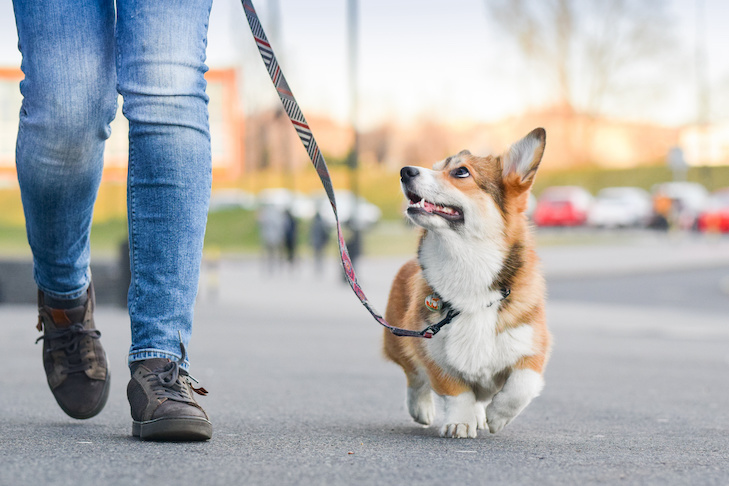Moving from a full house with a yard to run around in to an apartment, condominium, RV, or tiny home when you downsize can be a huge adjustment for dogs. They have less room both indoors and out, plus they might be sharing spaces like the lobby, elevators, or hallway with unfamiliar faces and animals. And in such close quarters, dogs need to stay quiet so they don’t disturb their neighbors and may have to learn to do their business off-site.
To make downsizing easier, there are a few skills to teach your dog to make the transition easier for both of you.
Prepare Your Dog for a New Environment
One of the best things you can do before moving to a new home is to give your dog a positive experience with it ahead of time. That could mean walking the neighborhood, sitting outside the building so your dog can smell, see, and hear the neighbors go by, or visiting the lobby. Pair the experience with something positive. You might feed your dog treats while you stroll around the block, or let your pup carry a favorite stuffed toy as you wander the halls.
On moving day, the change can be overwhelming for your dog. If they’re already familiar with the new environment, it will go a long way to easing their stress and teaching them to feel good about their new home. If you can, reward your dog for calm and quiet behavior during the move. Give your pet something to do, like chewing on a food-stuffed toy, and praise them for minding their manners. You don’t want your dog to start building bad habits, such as barking, on your first day.

Keep Your Dog Quiet
Once you’ve moved in, your dog will be flooded with unfamiliar noises from the hall and your neighbors. It’s important you teach your dog these sounds are no big deal. You don’t want noise complaints from your neighbors or the building manager because your dog won’t stop barking. In the beginning, pair noises with treats or a game, so your dog sees them as predictors of something fun rather than something worrisome. You can also mask noises by putting on the TV or playing music.
Although you can’t manage your neighbors, you can manage your dog. Keep them away from the front door where noises will be the loudest by barring the entranceway with a dog gate. You can also block your dog’s view out the window with plants or curtains so they can’t see arousing distractions. Once your dog is accustomed to your new environment, you can give them more freedom. But if your dog is still barking or anxious, consult a professional dog trainer or behaviorist about a counterconditioning and desensitization program.
It also helps to keep your dog occupied. For example, provide puzzle toys or feed your dog in a slow feeder so they can pass the time quietly engaged in mentally stimulating activities rather than barking at noises in the hall or chewing the baseboards. You can also use alone time training to teach your dog to feel comfortable in your new space when you go out. This will help prevent separation anxiety and save your home from damage. Finally, to nip any barking episodes in the bud, teach your dog to be quiet on cue.
Provide Exercise
RVs and tiny homes have very little spare space inside. The same can be true of some apartments or condos. Partner that with the lack of a backyard, and it will be challenging to meet your dog’s exercise needs. To tire your dog indoors, in addition to those puzzle toys consider playing brain games like hide-and-seek or trick training. Mental exercise can be exhausting for dogs. Or try nose work or an indoor agility course.
For outdoor workouts, provide your dog with at least one walk a day and find the local parks or trails for more prolonged activity. You could also take up a dog sport like flyball or disc dog to provide adequate exercise that’s fun for both you and your dog.

Manage Potty Breaks
If your new home lacks a yard, or you aren’t allowed to take your dog on the public grounds, potty breaks can be more complex. You need to get your dog to a preferred pee spot in time to prevent an accident. Establishing a routine can go a long way in predicting when your dog has to go. Choose set mealtimes and schedule your walks for the same time each day. You can also teach your dog to go to the bathroom on cue, which is incredibly useful in inclement weather.
If you have a puppy, unwell, or senior dog, you can also try potty pad training with pee pads or artificial turf. If you have a dog-safe balcony, you can use that as a toilet spot for emergencies or late-night potty breaks.
Politely Share Space With Other People and Dogs
If your dog will be sharing space with other people in your new abode, it’s important they be good canine citizens. Socialize your dog well so they are comfortable around strangers and other dogs in tight areas like the mailroom or elevator. Wait at doorways can also help with elevator etiquette.
It’s also important to teach your dog to wait for permission before interacting with other dogs and to sit for greetings so they don’t jump on your neighbors and their pets. You can always train your dog for the Canine Good Citizen (CGC) test, so you’re confident that your dog is able to interact in public and shared spaces appropriately. But you also need to educate yourself on where your dog is and isn’t allowed to ensure your dog is a welcome resident rather than a nuisance.

